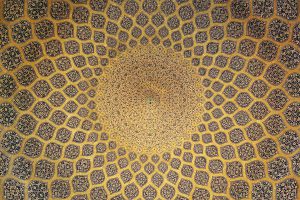Lām al-Taʿrif: Its Types and Some Examples

By Justin Poe (Takmīl Graduate, 2019)
In the following series of articles, we will look at some grammatical terms and issues that a student of knowledge will stumble across during his research in the subjects of tafsīr, uṣūl, naḥw, etc. These discussions are essential because the terminology used by the grammarians and the presence of these terms in books of other fields are not always consistent or may be idiosyncratic for a particular author.
The first resource for one who is researching a term and its usage is the encyclopedic reference works of naḥw and the works of terminology. For example, one can begin with Ibn Hishām al-Anṣārī’s Mughnī al-Labīb and Fāḍil Ṣāliḥ al-Sāmarrāʾī’s Maʿānī al-Naḥw and then move to Mawsūʿat al-Naḥw wa al-Ṣarf wa al-Iʿrāb of Amīl Badīʾ Yaʿqūb, Muʿjam al-Muṣṭalaḥāt al-Naḥwīyah wa al-Ṣarfīyah of Muḥmmad Samīr Najīb, and Muʿjam al-Qawāʿid al-ʿArabīyah fī al-Naḥw wa al-Ṣarf of ʿAbd al-Ghanī al-Daqar. These are just a few examples of books on this topic. Thereafter, he can check the source works (like Sibawayh’s al-Kitāb), works of uṣūl, and advanced grammatical texts, works that we will list in another article, inshāʾ Allāh.
The first topic we will explore is the lām al-taʿrīf or alif-lām. Recognition of this lām and its types is essential in uṣūl, tafsīr, balāghah, manṭiq, and argumentation (ar. ʿilm al-jadl).
Most students will be familiar with the lām al-taʿrīf or alif-lām that causes a noun to become definite, for example faras (horse) and al-faras (the horse) and the discussion around whether the lām causes the definiteness or the alif-lām or the hamzah.[1] This is the most basic meaning and use of the lām. The lām is attached to an indefinite noun and gives it definiteness. Nevertheless, the meaning of definiteness divides into three types: li al-jins, li al-istighrāq, and li al-ʿahd.[2] The latter further divides into three: al-khārijī, al-dhikrī and al-dhihnī. Even in the above division, there is difference. However, we will keep the discussion brief for this topic and focus on practical understanding. Below, we’ll explain each, with examples.
لام التعريف للجنس
The first is lām li al-jins. The word jins denotes a class of subjects, like “animal(s)” (ar. ḥayawān, pl. ḥayawānāt) for example. When this lām is joined to a noun, the entire class is intended, but not every individual of the class nor a specific individual. This lām specifies the quiddity (ar. ḥaqīqah or māhīyah) of the noun, its “whatness.”
For example, when I say, “water” or in a sentence, “Water is essential for life,” I mean the class of water, not a specific water (like water of the Atlantic Ocean) nor every water (e.g., rain water, tap water, etc.) and not water with all of its properties and characteristics (i.e. a colorless liquid that boils at 100°C and has a specific heat of 4.186, in normal conditions). I only mean the general class of water. Notice in English we sometimes do not use an article (i.e. “the” or “a”) before this type of definiteness.
This lām is often used in imprecise definitions,[3] generalized statements, and comparisons and is considered a “weak definiteness.” Its definiteness is considered weak because there could be exceptions of the class. And this lām does not denote all or every.
الذئب مفترس
“The wolf is predatory.”
المؤمن لا يكذب
“The believer does not lie.”
In these examples, the class is intended. The class of wolves are predatory animals. But there may be a particular wolf or group of wolves that may not be (i.e. domesticated). And a specific wolf is not intended. In the second example, the class of believers is intended, though it is possible that one may lie.
Allāh taʿālā says (Q 4:97):
إِنَّ الَّذِينَ تَوَفَّاهُمُ الْمَلَائِكَةُ الآية
“Verily, those whom the Angels take…”
The lām on “al-Malāʾikah” refers to the class of Angels and not every Angel.[4]
Allāh ʿazza wa jalla also says (Q 6:90):
…أَنزَلْنَا بِهِ الْمَاءَ…
“…We sent water down with it…”
The lām on “al-māʾ” refers to the class of water. There are many uses of this lām in the Qurʾān.
الإنسانُ خُلق من الطين
“Mankind is created from clay.” We intend the class of “clay” without intending every single type of clay or all clay. It would be incorrect to say, “the clay” as this would imply a specific clay.
لام التعريف للاستغراق
The second is lām li al-istighrāq. This lām is used to include all of the individuals of a class without exception. Furthermore, this lām is essential in constructing definitions. In logic, a definition should include all of the particulars of a class. To identify this lām, ask if kull (every, all) can be substituted for the lām.
الشَجَرُ نبَاتٌ له أُصولٌ وأَوراقٌ.
“The tree is a plant that has roots and leaves.” Notice here that in English we could say “A tree is a plant,” “the tree” or “trees are plants,” though a literal translation gives “the tree,” as in the example. In the above sentence, we intend all of the particulars of the class of things called “trees,” but not a specific tree. As a definition, every tree must have roots and leaves.
الإنسانُ خُلق من الطين
Here we have the above example again. “The human is created from clay.” The lām on “al-Insān” denotes all of the individuals in the class of things called “mankind/humans” without intending a specific individual. If we substitute with kull (every), the meaning would be sound. “Every human is created from clay.” It would be incorrect to say, “the human” as this would imply a specific individual.
الماسُ أثمن من الحَصاة
“The diamond is more precious than the pebble.”[5]
This could also be translated as “Diamonds are more precious than pebbles,” though this would not be a literal translation. The lām on both “al-mās” and “al-ḥaṣāh” means all or every one of the individuals of the class.
An example from the Qurʾān (Q 23:1):
قَدْ أَفْلَحَ الْمُؤْمِنُونَ
“The Believers have succeeded.”
The lām on “al-Muʾminūn” indicates all and every believer.
Finally, the lām can also be used to indicate all of the noun’s qualities, usually in praising or blaming, like “Fāṭimah is the researcher!” or “Aḥmad is the brave!” In both examples the individual is being praised with all of the qualities of the noun with the lām.
فاطمة هي المُحقِّقة أحمد هو الشُّجاع
لام التعريف للعهد
Next, there is the lām li al-ʿahd. The word ʿahd means “knowledge” or “recognition.” This lām is used when the addressee is aware of the particular noun that is referenced.
The first of this type is al-khārijī (external). When the lām li al-ʿahd is used in this meaning it indicates that the specified noun is existing in the external world, present and is known to the addressee. For example, “I bought the car from you.” The “the” on “the car” means that you are aware of the specific car that I am referencing and it exists and is present in the world.
اشتريتُ منك السيارةَ
The second type of al-ʿahd is al-dhikrī. This is the lām that attaches to a noun that was previously mentioned. The first time the noun is mentioned it is indefinite. Then, since it is known, it is definite with the lām.
Allāh taʿālā says (Q 73:15-16):
إِنَّا أَرْسَلْنَا إِلَيْكُمْ رَسُولًا شَاهِدًا عَلَيْكُمْ كَمَا أَرْسَلْنَا إِلَىٰ فِرْعَوْنَ رَسُولًا فَعَصَىٰ فِرْعَوْنُ الرَّسُولَ فَأَخَذْنَاهُ أَخْذًا وَبِيلًا
“Indeed, We sent to you a messenger bearing witness over you just as We sent to Firʿawn a messenger. Then, Firʿawn disobeyed the Messenger, so We seized him [with] a disastrous seizing.”
In āyah 15, Allāh mentions sending a messenger to Firʿawn. Then, the messenger is mentioned in āyah 16 with the lām because the listeners are aware of which messenger is being referred to (the same messenger in 15).
Lastly, the third type of al-ʿahd is al-dhihnī. This lām indicates a specific noun that, although not mentioned nor perhaps present at the time, is understood by the addressee due to previous knowledge or context. For example, “There’s a nice restaurant in the city.” If the speaker and addressee live in Illinois, then they understand that “the city” refers to Chicago.
Allāh taʿālā mentions (Q 95:3):
وَهَـٰذَا الْبَلَدِ الْأَمِينِ
“And by this secure city.”
The “city” referred to is Makkah. The Messenger ṣallā Allāhu ʿalayhi wa sallam and the Companions raḍi Allāhu ʿanhum knew that the city referenced was Makkah due to context.
التطبيق على الحمد
Finally, let’s look at a practical example: the ḥamd (praise) in al-ḥamdu lilLāh. The ʿulamāʾ of tafsīr have discussed the lām in the ḥamd of Sūrat al-Fātiḥah. Below, the discussion is abridged.[6]
Opinions and detailed analyses have been given for each of the above types of lām, that is, the lām li al-jins, lām li al-istighrāq, and lām li al-ʿahd, as possible for “al-ḥamd.” The opinions differ, for one, due to the categorization of the types of lām. For example, some grammarians consider lām al-jins to be under al-ʿahd. However, we will examine the lām on ḥamd based on the division presented above.
Allāh taʿālā states that ḥamd belongs to Him; He is entitled to it. This would either mean that He is entitled to the class of ḥamd (its quiddity), every individual ḥamd (and its qualities), or a particular ḥamd, whether understood mentally, previously mentioned, or based on prior knowledge and context.
We cannot say that the ḥamd is for al-ʿahd because a specific ḥamd has not been referenced. Thus, al-khārijī is excluded because we are not aware of all ḥamd of the maḥāmid (sing. ḥamd) being referred to existing in the external world; for al-dhikrī this particular ḥamd has not been mentioned before this ḥamd; and for al-dhihnī the listener does not understand from this ḥamd a particular ḥamd.
As for al-jins, this is a possibility since Allāh ʿazza wa jalla is entitled to the class of praises and the quiddity of praise. An objection has been raised in that al-jins could imply that Allāh taʿālā is not entitled to some praises. And this would have theological implications.[7] One should take note here that there is an important principle: one may not assume that an author’s grammatical opinion or tafsīr of a word or āyah is by default a necessary conclusion based their theological school. For example, al-Zamakhsharī (d. 538), the grammarian, mufassir, and scholar of balālagh, stated that the lām here is for al-jins. One could argue that he is motivated by his theological school of iʿtizāl, but this would be unfair to him unless he expressly stated that his grammatical choice was based on this. Rather, his field of expertise being grammar and balāghah should be seen as the primary factor in his opinion.
Nevertheless, one response is that the lām al-jarr on the majestic name Allāh (i.e. al-ḥamdu lilLāh) is for specification (ar. ikhtiṣāṣ) and thus the lām on ḥamd is for the class and this lām al-jarr specifies all praises for Allāh.
The lām li al-istighrāq then would seem a more appropriate candidate as it would encompass all of the types and particulars of praise. Although Allāh subḥānahu wa taʿālā is entitled to all praises, the lām al-jarr then would not have a purpose. From here we find another important principle in grammatical and rhetorical analysis of the Qurʾān. Every choice during analysis must be appropriate with prior and subsequent choices. Furthermore, Allāh taʿālā mentions in the subsequent āyāt the reasons why He is deserving of praise. Thus, the context tells us that al-jins is more appropriate.
And Allāh knows best.
[1] See for example, Sharḥ Qaṭr al-Nadā wa Ball al-Ṣadā of Ibn Hishām for a brief discussion.
[2] Grammarians have categorized the lām in additional ways. For example, some grammarians consider only two types of lām al-taʿrīf, divided to al-jins and al-ʿahd, and so on. The above categorization was chosen for clarity.
[3] Meaning, using the jins baʿīd instead of the jins qarīb or nawʿ in a definition.
[4] Ibn ʿĀshūr, al-Taḥrīr wa al-Tanwīr, 4:231.
[5] al-Sāmarrāʾī, Maʿānī al-Naḥw, 2:109.
[6] For the extended discussions, see Rūḥ al-Maʿānī (al-Ālūsī), Futūḥ al-Ghayb (al-Ṭībī), ʿInāyat al-Qāḍī wa Kifāyat al-Rāḍī ʿalā Tafsīr al-Bayḍāwī (al-Khafājī), Nawāhid al-Abkār wa Shawārid al-Afkār (al-Suyūṭī) and al-Taḥrīr wa al-Tanwīr (Ibn ʿĀshūr). Also see: al-Dhahab al-Ibrīz fī Nathr Masaʾil Fātiḥat al-Kitāb al-ʿAzīz (ʿAbd al-Raḥmān ʿAqīb, https://www.ahlalhdeeth.com/vb/showthread.php?t=330689).
[7] The Muʿtazilah and their doctrine that Man creates his own actions.


